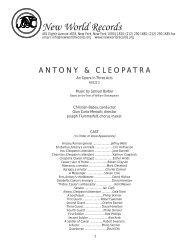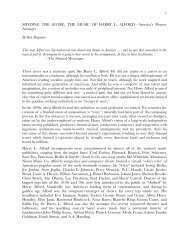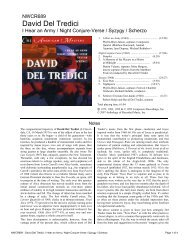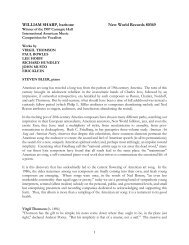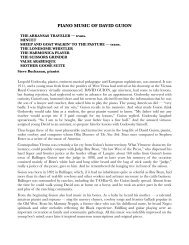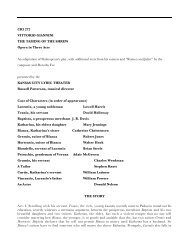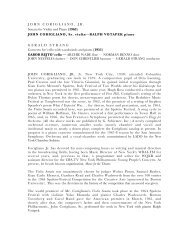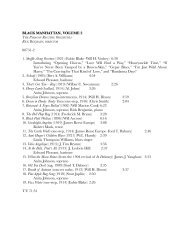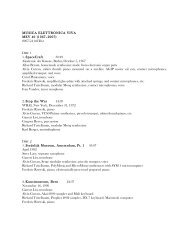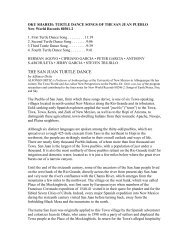ERICH ITOR KAHN SHORT PIANO PIECE from Op. 2 (1951) EIGHT ...
ERICH ITOR KAHN SHORT PIANO PIECE from Op. 2 (1951) EIGHT ...
ERICH ITOR KAHN SHORT PIANO PIECE from Op. 2 (1951) EIGHT ...
You also want an ePaper? Increase the reach of your titles
YUMPU automatically turns print PDFs into web optimized ePapers that Google loves.
<strong>ERICH</strong> <strong>ITOR</strong> <strong>KAHN</strong><br />
<strong>SHORT</strong> <strong>PIANO</strong> <strong>PIECE</strong> <strong>from</strong> <strong>Op</strong>. 2 (<strong>1951</strong>)<br />
<strong>EIGHT</strong> INVENTIONS, <strong>Op</strong>. 7 (1937-38): 1, 2, 3, 5, 6<br />
CIACCONA dei tempi di guerra, <strong>Op</strong>. 10 (1943)<br />
<strong>ERICH</strong> <strong>ITOR</strong> <strong>KAHN</strong> piano<br />
Recorded <strong>from</strong> a Hessischer Rundfunk Broadcast, 1955,<br />
and released by special permission<br />
EDMUND HAINES<br />
STRING QUARTET No. 4 (1957)<br />
OXFORD STRING QUARTET of Miami University<br />
ELIZABETH WALKER and ADON FOSTER violins<br />
JOSEPH BEIN viola ELIZABETH POTTEIGER ’cello<br />
<strong>ERICH</strong> <strong>ITOR</strong> <strong>KAHN</strong> (b. 1905, Rimbach, Germany — d. 1956, New York City) was cut down<br />
by fatal illness in the midstream of a career as composer and performer that commanded a<br />
devoted and intense following both in Europe and in his adopted country. Among the listening<br />
public at large, Erich Itor Kahn was best known as a chamber ensemble pianist of surpassing<br />
power and sensitivity. Few who heard his collaborations in concert and on recordings with the<br />
Albeneri Trio and with mezzo-soprano Jennie Tourel will allow them to fade <strong>from</strong> affectionate<br />
memory.<br />
Kahn’s childhood in the picturesque German town of Koenigstein was spent in an atmosphere of<br />
the arts, science, and humanist politics, since his father was a teacher and cantor and his mother a<br />
fine amateur singer. It was as in his early ’teens that he discovered the music of Arnold<br />
Schoenberg, whose aesthetic was to play a major role in his subsequent creative work; and by his<br />
sixteenth year, despite parental objection, he entered the Conservatory of Music at Frankfurt.<br />
Luck was with Kahn when, upon graduating <strong>from</strong> the Conservatory in 1928, he joined the staff of<br />
Radio Frankfurt as a musical director, and there had as collaborators, colleagues, and guest artists<br />
such figures as Hans Rosbaud (then staff conductor), Schoenberg, Stravinsky, Webern, Bartók,<br />
Roussel, Berg, Albert Schweitzer, Vladimir Horowitz, and Erica Morini.<br />
All this came to an end, however, with the coming of the Nazis; and Kahn and his pianist-wife,<br />
Frida, fled to Paris, there to begin a new life. By dint of constant playing and teaching, he became<br />
established once more. Again there came catastrophe, this time with the Nazi invasion of France;<br />
and after a harrowing series of internments in French refugee camps and desperate pleading with<br />
consular authorities, the Kahns finally made their way by boat to New York, again to begin a new<br />
career. That Erich Itor Kahn’s work as performer and composer is still very much alive in the<br />
memories of his pupils, colleagues, and those who heard him in the concert hall and on records<br />
speaks sufficiently for his achievements as an adoptive American.
As composer, Erich Itor Kahn produced a catalog of acknowledged compositions numbering<br />
about two-score works, extending over a period <strong>from</strong> 1930 (the Marienlieder, <strong>Op</strong>. 4, for soprano<br />
and piano) to 1954 (the String Quartet, <strong>Op</strong>. 13, and Vocalise, <strong>Op</strong>. 14, for five-part a cappella<br />
chorus). Though the serial concept was basic to Kahn’s musical thinking <strong>from</strong> first to last, his<br />
application of the Schoenbergian principle was essentially free — one might say even ecumenical<br />
in the Henry Cowell sense. For during his years in France, Kahn began working creatively with<br />
both French and Eastern European Jewish folk materials (Les Symphonies bretonnes, <strong>Op</strong>. 6a, Petite<br />
Suite bretonne, Trois Chansons populaires, <strong>Op</strong>. 6b, and the Three Madrigals and Chassidic Rhapsody<br />
comprising <strong>Op</strong>. 5). Understandably, too, Kahn was deeply affected by the fate of his friends and<br />
humanity at large caught up in the Nazi and subsequently general world holocaust. Hence the<br />
titles of such works as the Ciaccona dei tempi di querra recorded here, Nenia Judaeis qui hac aetate<br />
perierunt, <strong>Op</strong>. 11, for ’cello and piano, and the Actus Tragicus, <strong>Op</strong>. 12, for ten solo instruments.<br />
However, it should be emphasized that the use of folk material or evocative titles in no way<br />
vitiates the structural power of the works in question, but simply acknowledges the role of poetic<br />
impulse and inspiration in the creative act, together with those aesthetic principles that make for<br />
order and strength in the finished work of art.<br />
We are indebted to Mrs. Frida Kahn and to the Hessischer Rundfunk in Frankfurt for the use of<br />
the broadcast tape done by Erich Itor Kahn in June, 1955, scarcely nine months before his<br />
premature death in New York. The three works played by Erich Itor Kahn <strong>from</strong> his own output<br />
show the gnomic (Short Piano Piece), epic (Ciaccona), and lighter aspects (Inventions) of his work as<br />
musical creator.<br />
Notes René Leibowitz,<br />
“The Short Piano Piece shares its dense texture and elaborate pianistic style with the<br />
Bagatelles, <strong>Op</strong>. 8. There exists, despite the density, a remarkable natural flow in the<br />
discourse. In form, the work represents an amazing succession of small contrasting<br />
sections. Kahn’s individual ‘variation technique’ is based here on strict serial writing.” It<br />
was after hearing the tape used for this disc that Kahn decided in performing the work<br />
for his last recital in December, 1955, to repeat the whole main section (all save the<br />
introduction and coda) of the piece.<br />
“Ciaccona dei tempi di guerra,” Erich Itor Kahn tells us, “was composed in 1943. In a<br />
general way it projects the war experience, as its title indicates.<br />
“It is written in the old variation form which uses as its basis the constant repetition of<br />
the theme in the bass.<br />
“Its strict structure employs all kinds of contrapuntal procedures. It uses a free dissonant<br />
harmonic language, in the core of which strong tonal elements are incorporated.”<br />
Again we turn to René Leibowitz for authoritative commentary on the Inventions, <strong>Op</strong>. 7:<br />
“Eight Inventions, <strong>Op</strong>. 7, were composed in 1937-38. They are a group of pieces among<br />
which some express simplicity, some are complex. They represent different stages of the<br />
problems of tonality, serial writing, and strict 12-tone technique. They also reveal<br />
different approaches to pianistic problems as well as to the question of expansion. All<br />
this is treated with great variety of means, and with a constant Renewal of the musical<br />
inspiration.<br />
“1. Invention in C is composed throughout in two parts. The right hand performs<br />
musical passages derived exclusively <strong>from</strong> the scale of C major, while the left hand uses<br />
the components of the melodic C minor scale only.
2. Invention is written on a little Cradle Song. The texture is serial, without any<br />
reference to tonality.<br />
3. Invention uses a theme <strong>from</strong> Brahms’ Horn Trio [slow movement]. Despite the serial<br />
texture, the tonality of this theme is preserved.<br />
4. Invention is of large dimension, without any specific title [other than its basic<br />
expressive designation, Energico].<br />
5. Invention, Hommage à Ravel, is one of the most important pieces of the cycle. As a 12tone<br />
composition it is, of course, in no way related to Ravel’s composition technique,<br />
but something of the spirit and the varied fragrance of Ravel penetrate these pages.”<br />
EDMUND HAINES (b. 1914, Ottumwa, Iowa) has composed a sizable catalog of works in which<br />
virtually every musical performance medium is represented, save opera. In the course of teaching,<br />
writing, and lecturing over a nearly 25-year period, he has voiced unhesitatingly his views<br />
regarding the propriety — indeed, need—of today’s composer to take full advantage of the<br />
stylistic and technical resources offered in twentieth century music, this in accordance with the<br />
composer’s own special needs and goals. Mr. Haines’s own works exemplify this point of view in<br />
that they exhibit a wide variety of styles, some elements of which can be traced to Bartók and<br />
Stravinsky, while other aspects bespeak American regionalism and jazz, as well as cosmopolitan<br />
neo-classicism and atonality.<br />
“In music, as well as in the worlds of painting and poetry,” notes Mr. Haines, “one<br />
discerns in this century few common stylistic practices, but rather an explosion in all<br />
directions. I believe there are outlets and reasons for the coexistence of many idioms on<br />
the scene today. The accessibility of this variety of material frees the composer and at<br />
the same time inhibits his production. Each new composition represents to me, of<br />
course, a totally new problem in trying to weld style to content, a union perhaps more<br />
necessary during the past few decades than at any other moment in music history. I<br />
have tried to identify and accept my own spiritual and technical ancestors and I<br />
recognize that my idiom can shift unpredictably, but I am fairly certain that I shall stay<br />
in touch with some traditional information in my work. In this procedure, then, I have<br />
not been avant garde.”<br />
The first major milestone in Edmund Haines’s professional career came in 1941 when he was<br />
awarded a Pulitzer Prize for his First Symphony, as well as a Ph.D. <strong>from</strong> the Eastman School of<br />
Music. His composition teachers there were Bernard Rogers and Howard Hanson. Among his<br />
mentors in subsequent composition study have been Roy Harris, Aaron Copland, and Otto<br />
Luening.<br />
Since 1948, Mr. Haines has been on the music faculty of Sarah Lawrence College. In 1957-58 he<br />
held successively two Guggenheim Fellowships and the post of composer-in-residence at the La<br />
Napoule Art Foundation in France, following which he fulfilled major composition commissions<br />
<strong>from</strong> the Ford Foundation and <strong>from</strong> Miami University of Ohio on the occasion of its<br />
sesquicentennial.<br />
Among the works of Edmund Haines recorded heretofore have been the Promenade, Air and<br />
Toccata for organ (Kendall), the Toccata for Brass Quartet (Golden Crest), and the Concertino<br />
for Seven Solo Instruments and Orchestra (CRI 153). Other major works in Mr. Haines’s catalog<br />
include the Symphony in Miniature, Variations for Orchestra, Informal Overture, Three Dances<br />
for Orchestra, Coronach for Brass, Timpani, and Strings. four string quartets, a violin sonata, two<br />
piano sonatas, Prelude, Blues, and Boogie, Suite for Two Pianos, and three works for women’s chorus
—Mary Saw her Son, Invocation for Women’s Chorus, and Dialogue <strong>from</strong> Job. The latter was<br />
commissioned by Harold Aks and the Sarah Lawrence Chorus on the occasion of their 1964<br />
European tour.<br />
Concerning the String Quartet No. 4, Mr. Haines tells us:<br />
“The Quartet No. 4 was composed in 1957 while holding the post of composer-inresidence<br />
at the La Napoule Art Foundation, La Napoule, France. It was composed on<br />
commission <strong>from</strong> the Oxford String Quartet for the sesquicentennial celebration of the<br />
Founding of Miami University, Ohio. The Oxford Quartet, which is the University’s<br />
quartet-in-residence, first performed it during the season following its composition, and<br />
has played it many times since on tour. In 1963, the Quartet No. 4 served as the music<br />
for a ballet by the choreographer Josephine Schwarz and has been presented in that<br />
form by the Dayton Civic Ballet and by the Pennsylvania Ballet Company.<br />
“Essentially, the Quartet No. 4 is a set of variations on three short ideas presented in the<br />
opening slow theme, freely treated and arranged to form groups that simulate<br />
‘movements’ rather than to stand in sharply alternating contrast. As originally<br />
composed, the nine sections are: Theme, Pastoral, Air (omitted in this recorded<br />
performance), Dance, Second Dance, Scherzo, Soliloquy, Toccata, Finale and Epilogue.<br />
“The first three sections represent a slow opening movement; the dances and scherzo a<br />
unit; the soliloquy and Toccata a movement-unit of contrasting moods and tempos; and<br />
the finale and epilogue a coda to the entire structure. The Air is an optional variation,<br />
and it is not performed on this recording.”<br />
During the period of the Quartet’s composition, the composer became involved with variation<br />
form in a number of works, including the Rondino and Variations for Orchestra. In the Quartet<br />
he uses harmonic materials of a more or less tonal nature, and occupies himself with matters of<br />
form and with the essential texture of the string quartet medium.<br />
NOTES PREPARED BY D. H.<br />
(Original liner notes <strong>from</strong> CRI LP jacket)



